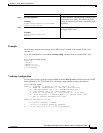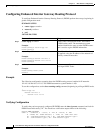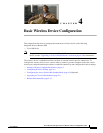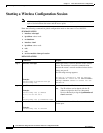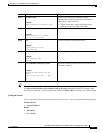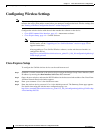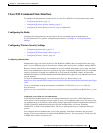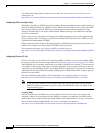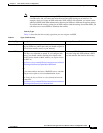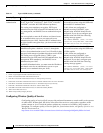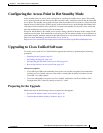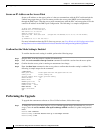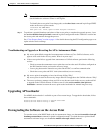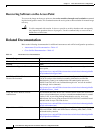
4-5
Cisco 880 Series Integrated Services Router Software Configuration Guide
OL-22206-01
Chapter 4 Basic Wireless Device Configuration
Configuring Wireless Settings
Cisco IOS Command Line Interface
To configure the Autonomous wireless device, use the Cisco IOS CLI tool and perform these tasks:
• Configuring the Radio, page 4-5
• Configuring Wireless Security Settings, page 4-5
• Configuring Wireless Quality of Service, page 4-8 (Optional)
Configuring the Radio
Configure the radio parameters on the wireless device to transmit signals in autonomous or
Cisco
Unified mode. For specific configuration procedures, see Chapter 9, “Configuring Radio
Settings”.
Configuring Wireless Security Settings
• Configuring Authentication, page 4-5
• Configuring WEP and Cipher Suites, page 4-6
• Configuring Wireless VLANs, page 4-6
Configuring Authentication
Authentication types are tied to the Service Set Identifiers (SSIDs) that are configured for the access
point. To serve different types of client devices with the same access point, configure multiple SSIDs.
Before a wireless client device can communicate on your network through the access point, the client
device must authenticate to the access point by using open or shared-key authentication. For maximum
security, client devices should also authenticate to your network using MAC address or Extensible
Authentication Protocol (EAP) authentication. Both authentication types rely on an authentication server
on your network.
To select an authentication type, see Authentication Types for Wireless Devices at:
http://www.cisco.com/en/US/docs/routers/access/wireless/software/guide/SecurityAuthenticationTypes
.html.
To set up a maximum security environment, see RADIUS and TACACS+ Servers in a Wireless
Environment at:
http://www.cisco.com/en/US/docs/routers/access/wireless/software/guide/SecurityRadiusTacacs_1.htm
l.
Configuring Access Point as Local Authenticator
To provide local authentication service or backup authentication service for a WAN link failure or a
server failure, you can configure an access point to act as a local authentication server. The access point
can authenticate up to 50 wireless client devices using Lightweight Extensible Authentication Protocol
(LEAP), Extensible Authentication Protocol-Flexible Authentication via Secure Tunneling
(EAP-FAST), or MAC-based authentication. The access point performs up to 5 authentications per
second.
You configure the local authenticator access point manually with client usernames and passwords
because it does not synchronize its database with RADIUS servers. You can specify a VLAN and a list
of SSIDs that a client is allowed to use.



